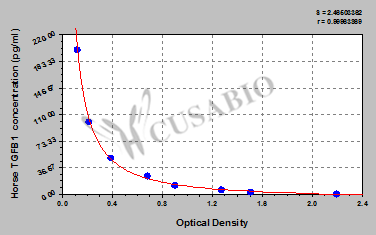-
中文名称:马转化生长因子β1(TGFB1)酶联免疫试剂盒
-
货号:CSB-EL023446HO
-
规格:96T/48T
-
价格:¥4200/¥3000
-
其他:
产品详情
-
产品描述:
This Horse TGFB1 ELISA Kit was designed for the quantitative measurement of Horse TGFB1 protein in serum, plasma. It is a Competitive ELISA kit, its detection range is 3.12 pg/mL-200 pg/mL and the sensitivity is 1.56 pg/mL.
-
别名:TGFB1 ELISA Kit; Transforming growth factor beta-1 proprotein [Cleaved into: Latency-associated peptide ELISA Kit; LAP); Transforming growth factor beta-1 ELISA Kit; TGF-beta-1)] ELISA Kit
-
缩写:
-
Uniprot No.:
-
种属:Equus caballus (Horse)
-
样本类型:serum, plasma
-
检测范围:3.12 pg/mL-200 pg/mL
-
灵敏度:1.56 pg/mL
-
反应时间:1-5h
-
样本体积:50-100ul
-
检测波长:450 nm
-
研究领域:Signal Transduction
-
测定原理:quantitative
-
测定方法:Competitive
-
精密度:
Intra-assay Precision (Precision within an assay): CV%<8% Three samples of known concentration were tested twenty times on one plate to assess. Inter-assay Precision (Precision between assays): CV%<10% Three samples of known concentration were tested in twenty assays to assess. -
线性度:
To assess the linearity of the assay, samples were spiked with high concentrations of horse TGFB1 in various matrices and diluted with the Sample Diluent to produce samples with values within the dynamic range of the assay. Sample Serum(n=4) 1:100 Average % 96 Range % 92-100 1:200 Average % 103 Range % 99-108 1:400 Average % 90 Range % 86-94 1:800 Average % 92 Range % 88-96 -
回收率:
The recovery of horse TGFB1 spiked to levels throughout the range of the assay in various matrices was evaluated. Samples were diluted prior to assay as directed in the Sample Preparation section. Sample Type Average % Recovery Range Serum (n=5) 86 82-90 EDTA plasma (n=4) 94 90-98 -
标准曲线:
These standard curves are provided for demonstration only. A standard curve should be generated for each set of samples assayed. 
pg/ml OD1 OD2 Average 200 0.126 0.131 0.129 100 0.228 0.213 0.221 50 0.384 0.396 0.390 25 0.697 0.659 0.678 12.5 0.908 0.872 0.890 6.25 1.233 1.284 1.259 3.12 1.464 1.507 1.486 0 2.099 2.215 2.157 -
数据处理:
-
货期:3-5 working days
引用文献
- Expression of IL-10 and TGF-β1 in horses experimentally infected with T. equi merozoites is associated with antibody production but not modulation of pro-inflammatory responses CK Onzere,Frontiers in immunology,2024
- Retinoic acid-mediated anti-inflammatory responses in equine immune cells stimulated by LPS and allogeneic mesenchymal stem cells Abdelhamid L.et al,Res Vet Sci,2017
相关产品
靶点详情
-
功能:Transforming growth factor beta-1 proprotein: Precursor of the Latency-associated peptide (LAP) and Transforming growth factor beta-1 (TGF-beta-1) chains, which constitute the regulatory and active subunit of TGF-beta-1, respectively.; Required to maintain the Transforming growth factor beta-1 (TGF-beta-1) chain in a latent state during storage in extracellular matrix. Associates non-covalently with TGF-beta-1 and regulates its activation via interaction with 'milieu molecules', such as LTBP1, LRRC32/GARP and LRRC33/NRROS, that control activation of TGF-beta-1. Interaction with LRRC33/NRROS regulates activation of TGF-beta-1 in macrophages and microglia. Interaction with LRRC32/GARP controls activation of TGF-beta-1 on the surface of activated regulatory T-cells (Tregs). Interaction with integrins (ITGAV:ITGB6 or ITGAV:ITGB8) results in distortion of the Latency-associated peptide chain and subsequent release of the active TGF-beta-1.; Multifunctional protein that regulates the growth and differentiation of various cell types and is involved in various processes, such as normal development, immune function, microglia function and responses to neurodegeneration. Activation into mature form follows different steps: following cleavage of the proprotein in the Golgi apparatus, Latency-associated peptide (LAP) and Transforming growth factor beta-1 (TGF-beta-1) chains remain non-covalently linked rendering TGF-beta-1 inactive during storage in extracellular matrix. At the same time, LAP chain interacts with 'milieu molecules', such as LTBP1, LRRC32/GARP and LRRC33/NRROS that control activation of TGF-beta-1 and maintain it in a latent state during storage in extracellular milieus. TGF-beta-1 is released from LAP by integrins (ITGAV:ITGB6 or ITGAV:ITGB8): integrin-binding to LAP stabilizes an alternative conformation of the LAP bowtie tail and results in distortion of the LAP chain and subsequent release of the active TGF-beta-1. Once activated following release of LAP, TGF-beta-1 acts by binding to TGF-beta receptors (TGFBR1 and TGFBR2), which transduce signal. While expressed by many cells types, TGF-beta-1 only has a very localized range of action within cell environment thanks to fine regulation of its activation by Latency-associated peptide chain (LAP) and 'milieu molecules'. Plays an important role in bone remodeling: acts as a potent stimulator of osteoblastic bone formation, causing chemotaxis, proliferation and differentiation in committed osteoblasts. Can promote either T-helper 17 cells (Th17) or regulatory T-cells (Treg) lineage differentiation in a concentration-dependent manner. At high concentrations, leads to FOXP3-mediated suppression of RORC and down-regulation of IL-17 expression, favoring Treg cell development. At low concentrations in concert with IL-6 and IL-21, leads to expression of the IL-17 and IL-23 receptors, favoring differentiation to Th17 cells. Stimulates sustained production of collagen through the activation of CREB3L1 by regulated intramembrane proteolysis (RIP). Mediates SMAD2/3 activation by inducing its phosphorylation and subsequent translocation to the nucleus. Can induce epithelial-to-mesenchymal transition (EMT) and cell migration in various cell types.
-
基因功能参考文献:
- Within the limitations of the study design, production of COMP during healing of skin wounds does not appear to be influenced by wound type or anatomic site, nor does it appear to be correlated with TGF-beta1 concentrations. PMID: 21062324
- Peritoneal TGF-beta(1) concentration was higher in horses with severe gastrointestinal diseases, in horses with an altered peritoneal fluid, and in nonsurvivors. PMID: 20636783
-
亚细胞定位:[Latency-associated peptide]: Secreted, extracellular space, extracellular matrix.; [Transforming growth factor beta-1]: Secreted.
-
蛋白家族:TGF-beta family
-
数据库链接:
Most popular with customers
-
Human Transforming Growth factor β1,TGF-β1 ELISA kit
Detect Range: 23.5 pg/ml-1500 pg/ml
Sensitivity: 5.8 pg/ml
-
-
-
Mouse Tumor necrosis factor α,TNF-α ELISA Kit
Detect Range: 7.8 pg/ml-500 pg/ml
Sensitivity: 1.95 pg/ml
-
-
-
-













